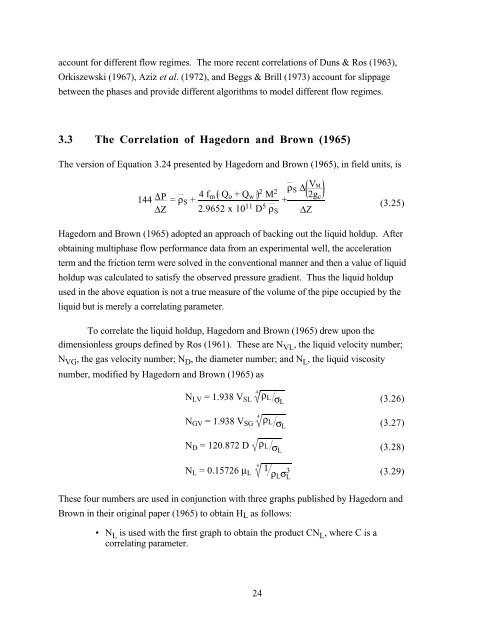multivariate production systems optimization - Stanford University
multivariate production systems optimization - Stanford University
multivariate production systems optimization - Stanford University
Create successful ePaper yourself
Turn your PDF publications into a flip-book with our unique Google optimized e-Paper software.
account for different flow regimes. The more recent correlations of Duns & Ros (1963),<br />
Orkiszewski (1967), Aziz et al. (1972), and Beggs & Brill (1973) account for slippage<br />
between the phases and provide different algorithms to model different flow regimes.<br />
3.3 The Correlation of Hagedorn and Brown (1965)<br />
The version of Equation 3.24 presented by Hagedorn and Brown (1965), in field units, is<br />
144 ΔP<br />
ΔZ = ρS + 4 fm Qo + Qw 2 M2 2.9652 x 1011 D5 +<br />
ρS<br />
24<br />
ρS Δ VM<br />
ΔZ<br />
2gc<br />
(3.25)<br />
Hagedorn and Brown (1965) adopted an approach of backing out the liquid holdup. After<br />
obtaining multiphase flow performance data from an experimental well, the acceleration<br />
term and the friction term were solved in the conventional manner and then a value of liquid<br />
holdup was calculated to satisfy the observed pressure gradient. Thus the liquid holdup<br />
used in the above equation is not a true measure of the volume of the pipe occupied by the<br />
liquid but is merely a correlating parameter.<br />
To correlate the liquid holdup, Hagedorn and Brown (1965) drew upon the<br />
dimensionless groups defined by Ros (1961). These are NVL , the liquid velocity number;<br />
NVG , the gas velocity number; ND , the diameter number; and NL , the liquid viscosity<br />
number, modified by Hagedorn and Brown (1965) as<br />
4<br />
NLV = 1.938 VSL<br />
ρL σL<br />
4<br />
NGV = 1.938 VSG<br />
ρL σL<br />
(3.26)<br />
(3.27)<br />
ND = 120.872 D ρL σL (3.28)<br />
4<br />
NL = 0.15726 μL<br />
1 3<br />
ρLσL (3.29)<br />
These four numbers are used in conjunction with three graphs published by Hagedorn and<br />
Brown in their original paper (1965) to obtain HL as follows:<br />
• N L is used with the first graph to obtain the product CN L , where C is a<br />
correlating parameter.

















